- Becker et al. (2004). Bedout: A Possible End-Permian Impact Crater Offshore of Northwestern Austra... // Science , No.304, 1469-1476
- Haines P.W. (2005). Impact cratering and distal ejecta: the Australian record // Aus.Journal of Earth sciences. Vol.52, N.4/5. Aug./Oct. p.481-507
- Barash M.S. (2013). Interaction of the Reasons for the Mass Biota Extinctionsin the Phanerozoic // Oceanology, 2013, Vol. 53, No. 6, pp. 739-749.
- Glikson A. (2017). Structure and origin of Australian ring and dome features with reference to the search for asteroid impact events.
- Glikson A. (2018). Structure and origin of Australian ring and dome features with reference to the search for asteroid impact events // Tectonophysics. - V. 722. - P. 175-196.
Расположен на континентальном шельфе
Наибольший интерес вызвало обнаружение того факта, что в период самой большой, Пермско-Триасовой биокатастрофы, иногда именуемой ещё "Великим Побоищем" (когда погибло, как считается, до 90 процентов тогдашних биологических видов), Земля была усыпана и сажей с пеплом, и фуллеренами с космическими газами, и иридиевыми осадками, и "потрясённым кварцем" с"микросферуллами" и железоникелевыми зёрнами.
...недавно в районе Беду, на северо-западе Австралии, был обнаружен засыпанный землёй древний метеоритный (или астероидный) кратер, по размерам (200 километров в диаметре) превосходящий даже тот кратер на полуострове Юкатан (180 километров в диаметре), который считается остатком столкновения, погубившего динозавров. Возраст этого кратера в Беду был определён нашедшими его геологами в 200-250 миллионов лет, что вполне годится для объяснения "Великого Побоища". Метеорит или астероид, который мог породить такой огромный кратер, наверняка обладал достаточной массой и энергией, чтобы вызвать ещё более страшную биокатастрофу, чем гибель динозавров.
Недавно родилась свежая научная теория: 200 млн лет назад произошло падение еще одного метеорита, оно истребило всех нединозавров, зато динозавры пошли в рост.
Possible P/T impact crater. ...In the May 13 online Science, a team led by Luann Becker, a geochemist at the University of California at Santa Barbara, describes a possible impact crater off the coast of Australia that they dated to the same time period as the extinctions. It has all the stereotypical signs of an impact crater, says Robert Poreda, a geochemist at the University of Rochester in New York and one of the team members: the right size, age and other characteristics.
The researchers examined a circular uplifted feature under the ocean called the Bedout High, which resembles a common feature of impact craters. Additionally, the team found minerals in Antarctica and across Australia that they say had been shocked by an impact. Seismic imaging profiles, gravity anomaly data and the presence of impact-produced rocks from cores and cuttings from Bedout are consistent with a buried impact crater...
cm.
Renne et al., Is Bedout an Impact Crater? Take 2, Science 2004 306: 610-612
Data from (Becker et al., 2004b). The report generated several heated comments (Glikson, 2004; Renne et al., 2004; Wignall et al., 2004) and responses (Becker et al., 2004c, d; Becker et al., 2004a). Also discussed by (Gorter, 1998).
(Rajmon, 2005).
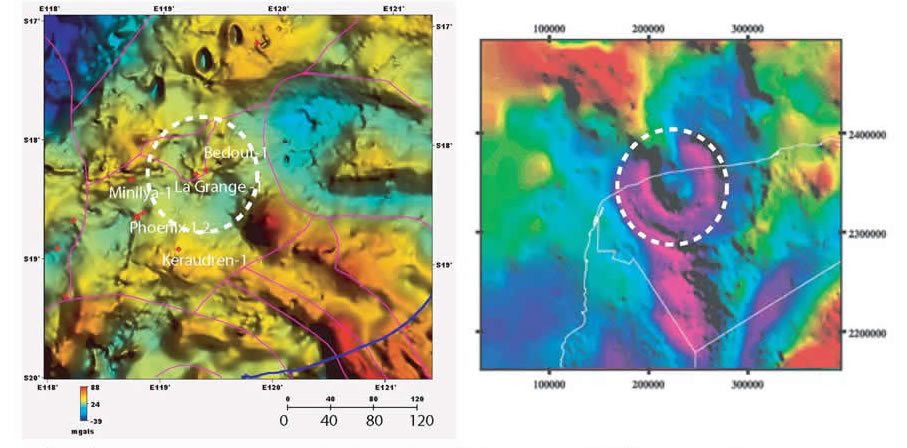 |
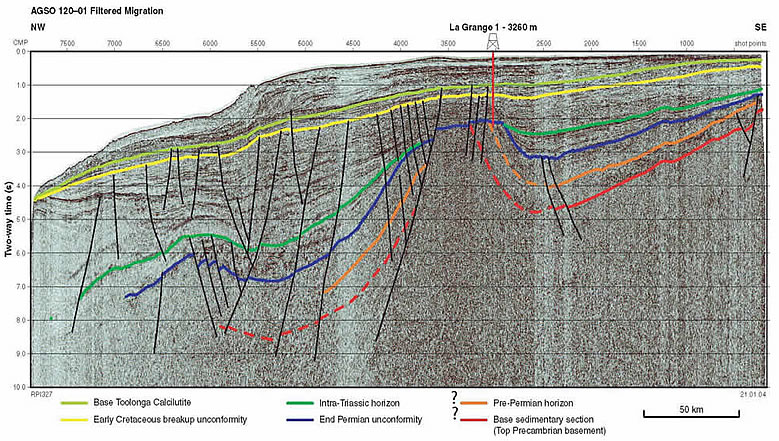 |
| Blow-up of isostatic residual gravity model over Bedout as compared with Bouguer gravity over Chicxulub (modified after 12) at approximately the same scale. Diameters of the central uplift (~40km) and transient crater (~100km, dashed circle) inferred from the gravity model for Bedout are similar in size to these features inferred for the Chicxulub impact structure. Gravity signature at Bedout is significantly reduced and more subdued than Chicxulub owing to its greater depth of burial (Bedout gravity model by Andrew Lockwood, GSWA, Perth Australia).
| Re-interpreted 1994 AGSO multichannel seismic line s120-01. This interpretation shows the central uplift of the inferred Bedout impact structure deforming end-Permian (dark blue line) and older sequences (Pre-Permian, orange dashed line and Top Precambrian basement, red dashed line), overprinted by younger faults associated with late-Triassic to mid-Jurassic rifting. The "pre-Permian strata", is inferred only from seismic character (15), yet appear to show uplift with the basement. These reflectors are carried from wells in the adjacent onshore Canning basin.
|
(Impact Deja Vu).
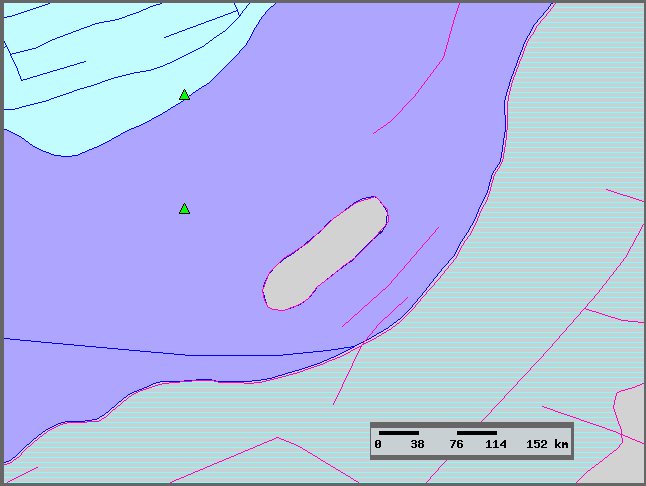
LMA |
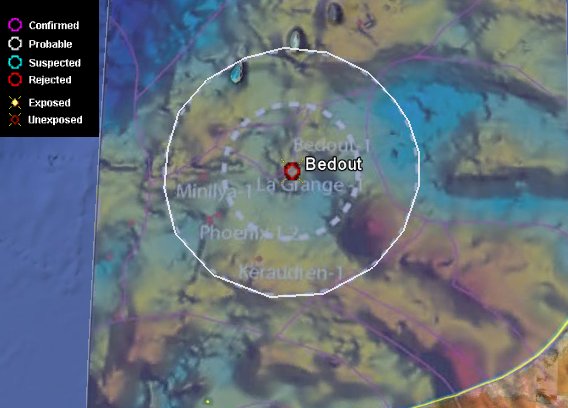
Спутниковая фотография кратера из Google Earth.
|
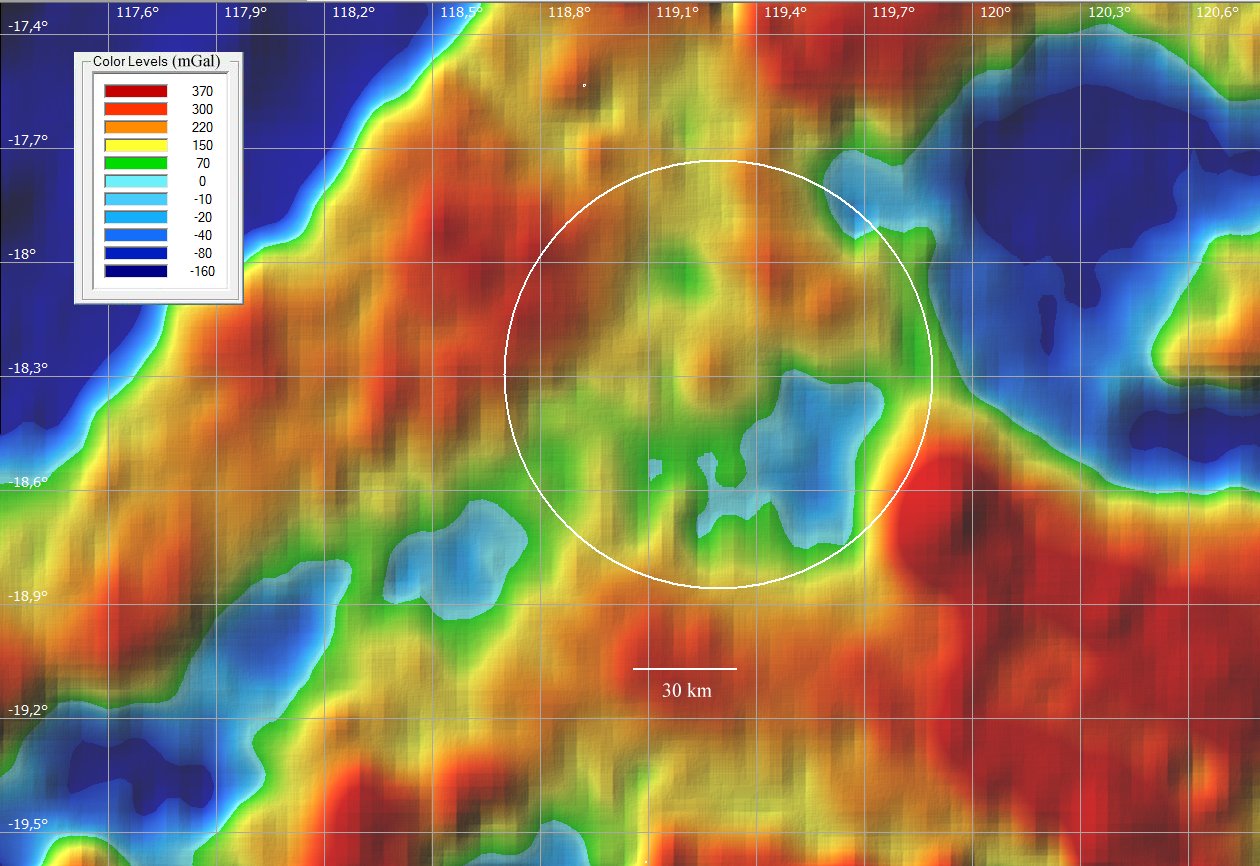
Аномалии силы тяжести (получено по данным GLOBAL MARINE GRAVITY V18.1 средствами системы ENDDB).
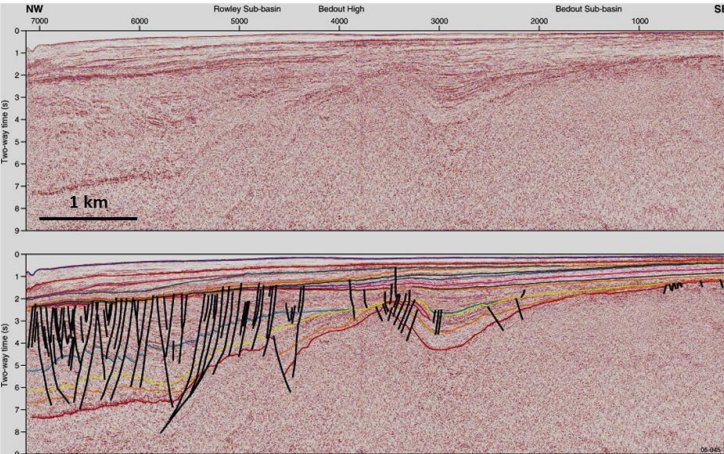
A NW-SE seismic section through the Bedout dome, offshore Pilbara coast, Western Australia
(Glikson, 2017).
На главную





